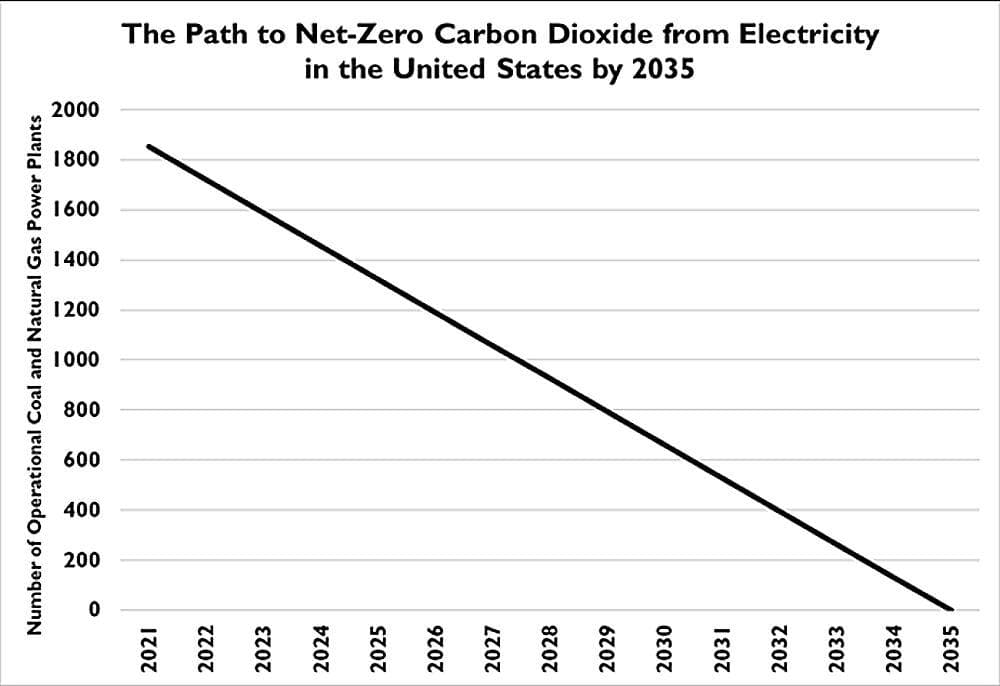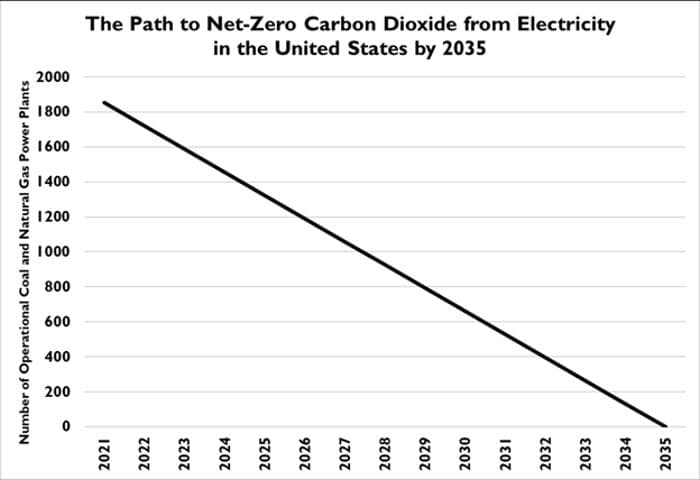The Biden Administration has established targets of reducing US GHG emissions by 50-52% by 2030 and achieving net zero emissions from the electricity sector by 2035. The Administration has not yet publicized a plan to achieve these targets.
Roger Pielke, Jr. recently proposed a simple, intuitive method for tracking climate policy progress which focuses on the required reduction in the number of fossil fueled electric generation plants in the US. The graph below illustrates a linear path to closing fossil fueled generating plants to achieve net zero emissions from the sector by 2035.

While Pielke’s method is indeed simple and intuitive, it is clearly unrealistic to assume that such a linear reduction in US fossil fueled generating plants could begin immediately, or even in the near future, if electric grid reliability is to be maintained.
The Administration’s stated intent is that the solar and wind generation equipment used to repower the US electric grid would be fabricated from US materials in the US, creating union jobs. The US does not currently have the production capacity to manufacture solar collectors and wind turbines in the quantities necessary to achieve the Administration’s stated targets on the announced schedule. Therefore, additional production capacity would have to be designed, permitted, constructed and commissioned if the schedule is to be met. This would require significant time, even if the government acted to hasten regulatory approvals.
Operating this new production capacity would increase electric consumption and fossil fuel consumption in the short term, requiring continued operation of existing generating capacity at higher levels of output, until sufficient incremental solar and wind generation equipment had been fabricated, sited, installed, connected to the electric grid and placed in service to provide the incremental power requirements of this new production capacity.
The intermittent nature of solar and wind generation requires supplemental power to support and stabilize the electric grid when solar or wind generation is unavailable. This supplemental power is currently supplied by the existing fossil fueled, nuclear, hydro and geothermal generating capacity. However, net zero operation would require replacing the fossil fueled portion of this capacity with either additional nuclear, hydro or geothermal generating capacity or grid-scale battery storage.
Grid-scale battery storage technology is not yet as mature as either solar or wind technology and the costs of this storage capacity are not yet commercially viable. Early storage technology forcing could dramatically increase the cost of the transition to renewables. Therefore, grid-scale battery storage capacity would probably lag increased solar and wind capacity by several years, until storage economics improve.
Once sufficient non-fossil generating capacity and battery storage capacity have been permitted, sited, constructed and commissioned existing fossil generating capacity could be retired at the rate of approximately 1 gigawatt of rating plate fossil generating capacity per 4 gigawatts of rating plate solar generating capacity or 3 gigawatts of wind generating capacity. The availability of sufficient conventional generating capacity to support and stabilize the grid during periods of low renewable generation would reduce these rating plate capacity ratios. However, reliance on a greater fraction of battery storage would require increased renewable rating plate capacity to compensate for the inefficiency of the battery storage systems.
These considerations suggest that the number of conventional powerplants would remain relatively stable for the first several years, then decline more sharply than envisioned by Dr. Pielke in the graph above. The remaining coal fired generators would be expected to be shutdown first as their CO2 emissions per gigawatt are higher than for combined-cycle natural gas plants and they are less able to respond the fluctuating supply and demand on the grid.

